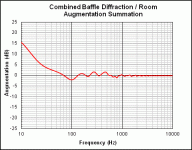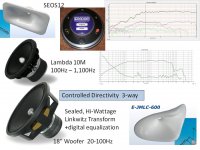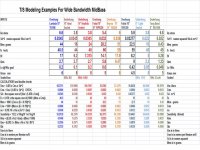or it just lost its built in flex control mechanism, or inner damping
I believe only the really heavy coned subwoofer drivers have real pistonic behaviour
btw, it looks to me like quite many of the new pro woofer designs have severe breakup peak
probably due to stiffer cones
but I guess pro people dont care so much about a small peak, and like the stiff cone more
Well, it's still in breakup mode when it's self-damping, it's just controlled, damped breakup.
I think with the pro stuff, dsp is so prevalent that out of band peaks are simply a non-issue.
I have a pair of NIB AE TD18H+ woofers I'd sure like to incorporate into somebody else's big build.
I think there are three ways to love the Lambda TD18H+ as a BASS woofer:
1) Use a LARGE solid state amp plus digital crossovers with digital room equalization to BEAT THE BRUTE TO YOUR WILL.
2) Simulate your room gain effects and shove the cabinet against the back wall, or into a corner, with a custom equalized crossover to obtain good quality low bass.
3) Build a LARGE rear bass horn.
GO'ing large allows a cabinet width of 26"-32" which allows the bass-midbass crossover to also cover the baffle step compensation. This both simplifies the Xover and allows the midbass to push its maximum SPL/watt efficiency.
==========
I think there are several reasons the engineers at Altec and JBL built large speakers around a 10" midbass like the JBL 2012H:
1) 10" is capable of covering the vocal range or 80-100Hz to 1100-1300Hz
2) 10" is capable of 95-97db/watt efficiency
3) 10" has a polar response ~90 degrees at 1100-1300Hz, which mates well with a 90x40 horn/waveguide that is recommended for multi-seat home audio.
4) Golden ear reviewers of JBL 2012H and Lambda TD10M midbass speakers say YES.
Attachments
Last edited:
GO'ing large allows a cabinet width of 26"-32" which allows the bass-midbass crossover to also cover the baffle step compensation. This both simplifies the Xover and allows the midbass to push its maximum SPL/watt efficiency.
==========
I think there are several reasons the engineers at Altec and JBL built large speakers around a 10" midbass like the JBL 2012H:
1) 10" is capable of covering the vocal range or 80-100Hz to 1100-1300Hz
2) 10" is capable of 95-97db/watt efficiency
3) 10" has a polar response ~90 degrees at 1100-1300Hz, which mates well with a 90x40 horn/waveguide that is recommended for multi-seat home audio.
4) Golden ear reviewers of JBL 2012H and Lambda TD10M midbass speakers say YES.
10inch seems preferable but maybe thats lust rather than thoughtful selection
Can't quite stretch to the Lambda's at the moment. But I notice it is low mms, very low qts and high dB/w/m, meaning Bruce Lee speed and control but not enough weight & power for the 'one inch punch'?
What sound difference would this have to a heavier cone with a middling qts of say 0.35? And as for polar response - theres another hat in the ring
Bruce Lee's light weight did not stop him from delivering a killer one-inch punch.  The 10 inches with very strong motor, Qts<0.25 and Fs>60Hz will really start to get a higher f3 in the small sealed cavity, so it's a matter of modelling what fits your need. But I do believe that the higher sensitivity, low Qts and low Mms will deliver the most dynamic performance and plenty of punch.
The 10 inches with very strong motor, Qts<0.25 and Fs>60Hz will really start to get a higher f3 in the small sealed cavity, so it's a matter of modelling what fits your need. But I do believe that the higher sensitivity, low Qts and low Mms will deliver the most dynamic performance and plenty of punch.
IG
IG
Bruce Lee's light weight did not stop him from delivering a killer one-inch punch.The 10 inches with very strong motor, Qts<0.25 and Fs>60Hz will really start to get a higher f3 in the small sealed cavity, so it's a matter of modelling what fits your need. But I do believe that the higher sensitivity, low Qts and low Mms will deliver the most dynamic performance and plenty of punch.
IG
no messing with Mr Lee! Even if the punch is delivered with enough speed & force isn't the weight (Mms) important? Or is that just low bass? Is this one of the differences between mid & bass drivers?
I very much appreciate your help with this IG
BLIVIT
What is emphasized, from the music being conveyed through UTube, is the acoustics of rooms too-small for the loudspeakers units placed in them. As far as loudspeaker design is concerned, JBL's versions of Ranger's Paragon and Hartsfield’s corner horn outshine them all. For the ultimate in performance, the products from TAD have few peers. For all the cases presented here, the room acoustics is killing sound quality; thus, the cost of largeness, constitutes a misdirected expenditure.
Regards,
WHG
I really love the videos of HUGE JBL's and big ol' Altecs on various sites. The sheer size of the cabinets and visceral presence of the sound they seem, and are reported to produce is intriguing and 'lust worthy'. Especially the big 4350 & 4355 and Kenrick Sounds own 4351 (a vertically arranged 4355)
What is emphasized, from the music being conveyed through UTube, is the acoustics of rooms too-small for the loudspeakers units placed in them. As far as loudspeaker design is concerned, JBL's versions of Ranger's Paragon and Hartsfield’s corner horn outshine them all. For the ultimate in performance, the products from TAD have few peers. For all the cases presented here, the room acoustics is killing sound quality; thus, the cost of largeness, constitutes a misdirected expenditure.
Regards,
WHG
no messing with Mr Lee! Even if the punch is delivered with enough speed & force isn't the weight (Mms) important? Or is that just low bass? Is this one of the differences between mid & bass drivers?
I very much appreciate your help with this IG
IMO, a light Mms can be punchier. The heavy cones are often used to get Fs down and produce more bass, at the expense of upper-bass and midrange sensitivity. There are upsides and downsides to this, as everything in audio is a tradeoff, I just think the ups outweight the downs, for my preferences.
IG
What is emphasized, from the music being conveyed through UTube, is the acoustics of rooms too-small for the loudspeakers units placed in them.
I know that no matter the quality of the recording & sound equipment (& Kenrick Sounds uses HIGH quality gear mounted on a FigRig) the sound of a loudspeaker cannot then be reproduced with another amp & speakers. Also the room in which the recordings are made is a large commercial space so at least when recorded they are being played in an adequate space.
As far as loudspeaker design is concerned, JBL's versions of Ranger's Paragon and Hartsfield’s corner horn outshine them all. For the ultimate in performance, the products from TAD have few peers.
What is it about corner horn/placement that makes it better? Again, high cost drivers are not going to appear in this project. I just don't have the funds available
For all the cases presented here, the room acoustics is killing sound quality; thus, the cost of largeness, constitutes a misdirected expenditure.
What do you mean 'for all the cases presented here?' So big speakers are a fail no matter what?
IMO, a light Mms can be punchier.
My ears prefer a good transient response over the bottom octave. Mind you I don't watch movies so that might be part of it.
My ears prefer a good transient response over the bottom octave. Mind you I don't watch movies so that might be part of it.
Of course- you CAN use "true subs" for the super deep stuff and focus on the punch for the midbass (down to, say, 50) and grab the best of both worlds.
My ears prefer a good transient response over the bottom octave. Mind you I don't watch movies so that might be part of it.
Of course- you CAN use "true subs" for the super deep stuff and focus on the punch for the midbass (down to, say, 50) and grab the best of both worlds.
I dont really care about movies either Cal. If the story is rubbish and its badly stitched together with CGI and rumbling explosions its not worth watching.
Transient response, the speed of articulation of a sound, is what floats my boat. I'd happily loose the lower freq. if I get clarity, immediacy and detail.
So i think I'll chose a 10" for the mid. Where abouts to cross it over depends on the driver but 2k is my goal.
A 10" with say 9" diameter radiating surface will start to beam over ~1500Hz. Well, it's not like a brickwall thing, it's gradual, but you might get away with 2kHz Xover if the HF unit above this has a controlled directivity that matches that of the 10" at this point.
Karlsons do well at trading off low-end for punch.
IG
Karlsons do well at trading off low-end for punch.
IG
Transient response, the speed of articulation of a sound, is what floats my boat. I'd happily loose the lower freq. if I get clarity, immediacy and detail.
You can do that with subs. Also things start to sound a bit thin without that last octave and a half. Just pick the right midwoofers and subs and it can sound really good with the solid foundation subs give you and all the snap you are looking for.
Rob
Answers
For all the examples provided, none contained inexpensive drivers. Apply the lumber cost savings, accruing from use of smaller enclosures, to upgrade the drivers you plan to use.
All the YouTube recordings I listened to exhibited the acoustics of too-small, acoustically untreated rooms. The point is: spend some of the large loudspeaker budget on room treatment and make the loudspeakers smaller. The size of a loudspeaker enclosure has to do primarily with its low frequency limit and the amount of energy required to reproduce it. For higher frequencies, enclosure size is not at issue, but room acoustics, never the less, remains to be addressed.
Regards,
WHG
The room corner serves as the required extension of the horn body anticipated by the enclosure design. The assumption here at issue, is that the room is big enough to fulfill that requirement.>snip<
What is it about corner horn/placement that makes it better? Again, high cost drivers are not going to appear in this project. I just don't have the funds available.
For all the examples provided, none contained inexpensive drivers. Apply the lumber cost savings, accruing from use of smaller enclosures, to upgrade the drivers you plan to use.
When at the expense of room size and acoustical treatment, the answer to the second question is yes.What do you mean 'for all the cases presented here?' So big speakers are a fail no matter what?
All the YouTube recordings I listened to exhibited the acoustics of too-small, acoustically untreated rooms. The point is: spend some of the large loudspeaker budget on room treatment and make the loudspeakers smaller. The size of a loudspeaker enclosure has to do primarily with its low frequency limit and the amount of energy required to reproduce it. For higher frequencies, enclosure size is not at issue, but room acoustics, never the less, remains to be addressed.
Regards,
WHG
Last edited:
A 10" with say 9" diameter radiating surface will start to beam over ~1500Hz. Well, it's not like a brickwall thing, it's gradual, but you might get away with 2kHz Xover if the HF unit above this has a controlled directivity that matches that of the 10" at this point.
Karlsons do well at trading off low-end for punch.
IG
I saw you family of Karlsons - quite an achievement!
yeah 2khz is an outside figure. hopefully making for an easier crossover with the HF.
JBL us a longish, circular narrow 'horn' and then a slot loaded uhf driver. As using 4 drivers in in the upper registers will necessitate another amp and 2 more drivers, I think 3-way will do for now
would a nice CD driver and 90x40 horn meet up best with the mids? or is there a dome out there?
I think there are three ways to love the Lambda TD18H+ as a BASS woofer:
Thanks for the thoughtful reply, but I worded my previous statement poorly.
What I meant to say was that I have a pair of AE TD18H+ woofers and I'd like to see somebody else build something big with them.
with good well behaved speakers you wont need special room treatment
unless you have a really 'nervous' room
but might be true that many speakers using pro drivers could tend to be a bit 'nervous', and thus may need room treatment to sound good
unless you settle at calling it honest, analytic, clean, pure, true, or whatever suits
unless you have a really 'nervous' room
but might be true that many speakers using pro drivers could tend to be a bit 'nervous', and thus may need room treatment to sound good
unless you settle at calling it honest, analytic, clean, pure, true, or whatever suits
- Status
- This old topic is closed. If you want to reopen this topic, contact a moderator using the "Report Post" button.
- Home
- Loudspeakers
- Multi-Way
- And Now For Something REALLY BIG


